It was now three years ago that I spent my birthday weekend at the 150th Appomattox commemoration. You can read about it here, here, here, and here. History friend Mel and I spent four days touring both the historical village of Appomattox Court House and the local industrial complex with the more vigorous reenactments and a much larger cadre of living historians. This included saying farewell to Al Stone as General Lee of Lee’s Lieutenant’s, a Confederate officer reenacting group I had seen for years around the Northern Virginia battlefields. Mr. Stone was the best incarnation of Lee I’ve seen in person or in cinema and it was sad, yet fitting, that he was going to officially retire after the 150th Appomattox.
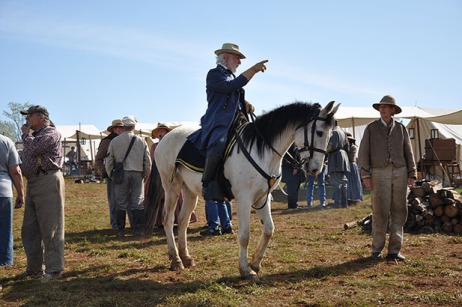
Al Stone at the Appomattox 150th in 2015.
Anyway. Fast forward two weeks from then.
My Civil War discussion group wanted to trace Lee’s retreat through Virginia to the final surrender at Appomattox, so we planned to start in Richmond and hit all of the stops on the way to Appomattox.
Here’s a little bit of history: After the Wilderness campaign (May 5-7, 1864), Lee retreated south to Richmond and Grant, instead of withdrawing, decided to follow. Both sides met in a number of skirmishes and battles as Grant tried unsuccessfully to turn Lee’s flank. At Richmond and Petersburg, Lee dug his heels in to protect both the Confederate capital and one of the main supply lines from the South. For nine months, both sides tried to break the siege, including events like The Crater and New Market Heights. In March, Lee, in an attempt to break the stalemate, tried breaking Union lines at Fort Stedman, was repulsed, and both Petersburg and Richmond fell a week later on April 2, 1865. Grant pursued the retreating rebels along the Appomattox River, engaging in a number of small skirmishes until a final battle a week later at the tiny village of Appomattox Court House convinced Lee that he had lost. He surrendered April 9, 1865.
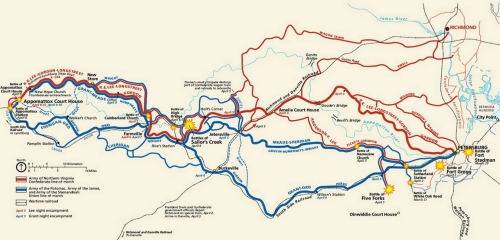
The course(s) of Lee’s Retreat.
Our group spent most of that Saturday (April 25 for anyone who’s keeping track) at Petersburg. Starting on the eastern side of the battlefield, we began a nice driving tour where everything had been well marked. It was interesting to see the forts/bastions, or what was left of them. Most of the fortifications had rotted away and were grown over in grass, but all were still distinctly forts based on the formations of the ground. One of the stops on the tour had a recreated fort so we could see what it would have looked like in working condition. I always find it interesting to see how Victorian technology worked. Sometimes I think we don’t give those guys enough credit for their engineering skills because obviously our modern technology is superior.
Unfortunately the day was soggy and just got soggier as it progressed so that really put a damper (ha. ha.) on our fun. Still, it was really cool to look out at the (soggy) landscape and be able to see the earthworks and trenches still extant.
We had lunch and tried to dry off at a tavern/sports bar called Longstreet’s. Because we were who we were, we had to ask the waitress if she knew who Longstreet was. She had no idea, but she was sweet as sugar. The hot tea/coffee and soup did an adequate job of rejuvenating us before we went back out into the wetness.
There were several more stops before the highlight of the day. One was Fort Stedman, where there was discussion of Lee’s last attempt to break the Siege of Petersburg. We also wanted to go exploring down some paths that led away from the Fort, but one was closed off because it was an eagle wildlife area, and to violate that sign was to the tune of a $350,000 fine and 3.5 years in jail…… So we took the other route that ended at a monument to the 1st ME Heavy Artillery Unit, where that unit suffered the single greatest loss of life in a single day of battle in the Union.
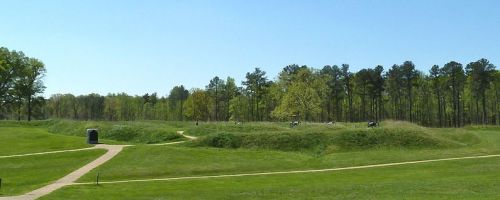
Fort Stedman (photo not taken by me … far too sunny for that)
Penultimate to the Crater was Burnside’s vantage point from which he watched the Crater happening. There wasn’t much there, but cannons were set up and the grass was mowed to indicate the fort/battery. Also, weirdly enough, there were the ruins of a kitchen from a pretty large house that predated the war. Information on the kitchen and the farmhouse is scant. The thing I noted about the position – it was certainly high ground, which probably interfered with perception of distance, but I would think that a figure sitting there on a horse would be a prime target and well within range of a skilled sharpshooter. But that is neither here nor there.
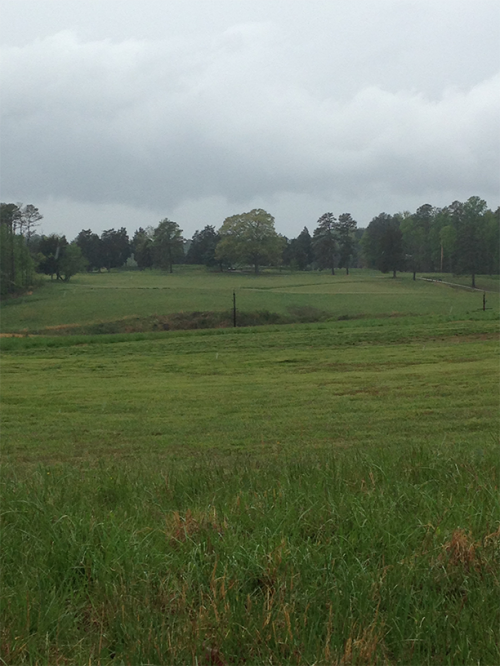
Burnside’s vantage point. To the far right, you can see a paved path that goes past the entrance to the mines, which is just off camera. The Crater itself is in the middle right in that copse of trees. It doesn’t look like very much distance between the vantage point and the point of explosion … because it wasn’t.
The climax of the day was, naturally, The Crater. From the layout of the land, I simply cannot understand how the Confederates didn’t see a bunch of Union guys down in the valley and not coming out again. Maybe they thought the Union were sneaking back around to the side? The tunnel that was dug was also shorter than expected, although the entrance was well hidden. There was a diagram showing how ventilation worked – again, a fascinating look into Victorian technology. The entire tunnel had a single air shaft that was close to the entrance and behind Union picket lines. Any scouts would think the smoke leaving the tunnel was just from the pickets.

The entrance to the mines
And then – finally – we got to the Crater. Which was … underwhelming. Because it’s talked about in hushed tones and you can actually hear the capital letters of The Crater, I was expecting a little bit more, to be honest. One of the group members had been there before and warned us to be prepared for disappointment. I’m pretty sure I was expecting a gaping hole similar to a deep, jagged crater on the moon. This particular Crater had fathomable depth and distance. The signs also said that the hole had been immediately incorporated into the rest of the earthworks so it had already been altered since it first came to be. Well, ok then.
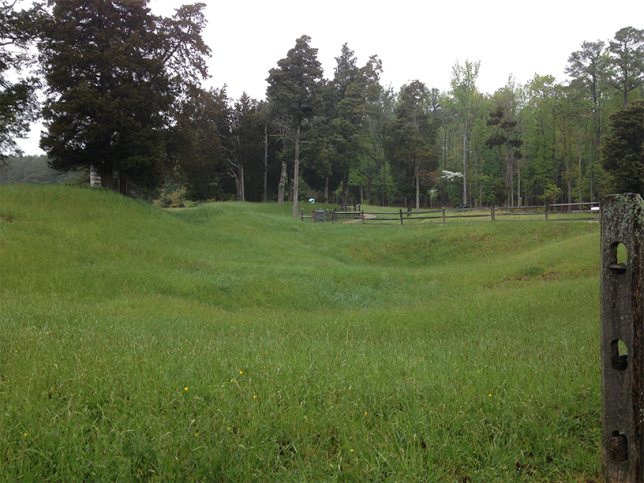
Behold: The Crater…
By that time we were cold and soaked through so we called it early and missed going to Five Forks. There was some regret from all parties present, but it was overpowered by a desire to get out of the rain. We checked into the hotel and took a breather. I, er, accidentally got my hair stuck in the hair dryer as I was using it to dry my shoes, and I had to borrow nail clippers from one of the guys to fix the situation.
We stayed the night at a moderately swanky hotel in a Richmond suburb called Short Pump and socialized with ourselves, friends of one of our group members, and later, people from the hotel lobby. I shot maybe two games of pool then called it a night to go read Wikipedia to get the details of the day set straight.
The whole day had been a wonderful learning experience, but it was made even better by the fact that I could share it with equally impassioned history nerds. And as a bonus, I got to strike Petersburg and The Crater from my list of Places to See.
Stay tuned for Day Two …
Links:
http://www.history.com/this-day-in-history/battle-of-fort-stedman-virginia



